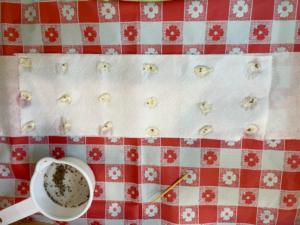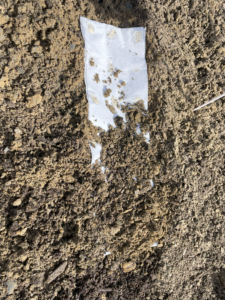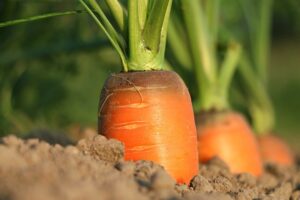In the world of gardening, few moments are as gratifying as the emergence of life from a tiny, seemingly lifeless seed. Some seeds are just more difficult than others to germinate, space, and plant. Carrot seeds are one such seed. They are quite tiny, and inevitably you plant too many too closely and have to thin them, which is time consuming and a waste of seeds. Carrot Germination is tricky, but I have a few tricks up my sleeve.
The Science Behind Carrot Seeds
Anatomy of a Carrot Seed
A carrot seed may seem plain to the naked eye, but a closer look reveals a complex structure designed for life. Each seed contains the potential for a taproot, the plant’s primary source of nutrient intake, and a shoot that will ultimately form the feathery greens we associate with carrots.
Factors Affecting Seed Quality and Viability
The viability of carrot seeds is influenced by several factors:
- Storage conditions: Humidity and temperature can significantly impact how long a seed remains viable.
- Genetic factors: Some cultivars naturally produce seeds with higher germination rates.
- Harvesting methods: Proper selection and timing of seed collection are crucial.
Optimal Conditions for Germination
Soil and Temperature Requirements
Carrots prefer loose, well-draining soil. This is vital as the sprouts are not strong enough to punch through a heavy soil. Amending with peat moss or simply growing in grow medium and them transplanting may be the best way to assure germination. The right temperature can also jump-start germination; aim for a soil temperature between 55°F and 75°F (13°C and 24°C) for the best results.
The Role of Moisture and Light
Consistent moisture is key for the first stages of growth, but carrots are not fans of being waterlogged. Lightly water your seeds immediately after planting, and ensure they receive at least six hours of sunlight daily once they sprout.
Steps to Promote Healthy Germination
In order to ensure healthy germination and strong growth from your carrot seeds, several key steps can be taken.
Seed Treatments for Enhanced Germination
Certain treatments can help carrot seeds germinate more quickly and successfully. These include:
-
- Hydration before planting: Pre-soaking seeds for a few hours can encourage swifter germination.
- Utilizing seed tape: This helps maintain optimal planting distances and is biodegradable.
- DIY seed tape methods: From making your own with toilet paper and flour paste to using the pinch method for even distribution. Just dap a small amount of the four past equal distances apart and put a seed in each dab. Plant the entire thing in a trench and cover loosely with soil.

Doing your own seed tape is easy!

- Mixing seed with sand and broadcasting to hopefully prevent over-sowing.
- Making a paste of corn starch and hot water to dissolve. After cooling adding and mixing your seeds. Use a baggie with a corner cut off, like a cake pipping bag to plant your seeds in a furrow.

- Use cardboard egg cartons with a hold in each egg space. Fill with growing medium and plant carrot seeds. When seedlings grow, plant the entire egg carton on your garden in a trench covered loosely with soil. You will want this to be on something solid as the cardboard will tend to fall apart when it’s time to move it
Optimal Spacing for Growth
Proper spacing ensures each carrot has room to grow. Use spacing guides or rulers during planting, and thin seedlings as necessary to maintain adequate distance.
Microclimate Management
Controlling the environment surrounding your carrot seeds can make a significant difference. Use floating row covers to protect your emerging plants from pests and maintain consistent soil temperatures.
Companion Planting for Natural Pest Control
Strategic companion planting can deter common pests like carrot flies. Consider interplanting your carrots with aromatic herbs or onions.
Common Challenges and How to Overcome Them
Gardening is not without its hurdles. Some of the most common challenges during carrot germination include poor soil quality, pests, and diseases. Here are some tips to address them:
- Optimizing soil conditions: Aim for a well-aerated, loamy texture by adding organic matter like compost.
- Pest management: Regularly check for pests, and use natural deterrents whenever possible. Carrot flies, for instance, detest the smell of strong-scented plants like rosemary and sage.
- Managing diseases: Rotating crops can minimize the risk of diseases, as can ensuring proper air circulation and avoiding overhead watering.
The Journey from Germination to Harvest
Once your carrots have successfully germinated, the work isn’t over. Carefully tend to your plants as they mature, checking for signs of stress and addressing them promptly. Thinning is an important process in the early stages, as it minimizes competition for resources. Finally, as your carrots approach maturity, give them a final check for any overcrowding and gently release the soil around them to prevent any obstructions to growth.
Conclusion
Mastering carrot germination is a key milestone on the path to sustainable gardening. By taking the time to learn and apply the techniques outlined in this post, you’ll not only enjoy the satisfaction of watching your carrots grow, but you’ll also be contributing to the health of your garden ecosystem. Share your experiences and tips with us, and keep in mind that each season offers new opportunities to refine your approach. Happy gardening!

